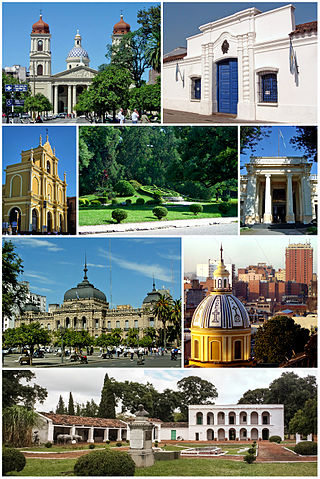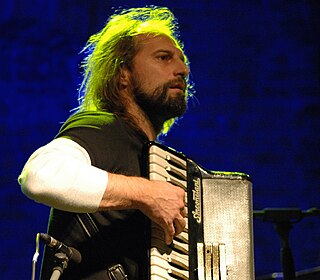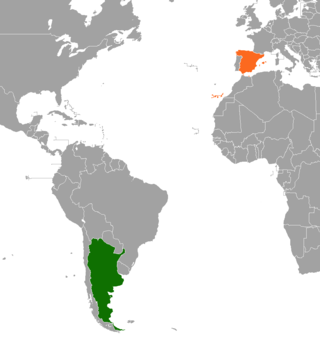
The music of Argentina includes a variety of traditional, classical and popular genres. According to the Harvard Dictionary of Music, Argentina also "has one of the richest art music traditions and perhaps the most active contemporary musical life.

San Miguel de Tucumán, usually called simply Tucumán, is the capital and largest city of Tucumán Province, located in northern Argentina 1,311 kilometres (815 mi) from Buenos Aires. It is the fifth-largest city of Argentina after Buenos Aires, Córdoba, Rosario and Mendoza and the most important of the northern region. The Spanish conquistador Diego de Villarroel founded the city in 1565 in the course of an expedition from present-day Peru. Tucumán moved to its present site in 1685.
Jesús María is a city in the province of Córdoba, Argentina, located 49 km due north from the provincial capital Córdoba, on National Route 9, within the valley of the Sierras Chicas. It has about 27,000 inhabitants as per the 2001 census [INDEC].

Horacio "Chango" Spasiuk is an Argentine chamamé musician and accordion player.

Jorge Antonio Cafrune was one of the most popular Argentine folklorist singers of his time, as well as an unflagging researcher, compiler, and diffuser of the native culture.

Argentina–Spain relations are the bilateral relations between the Argentine Republic and the Kingdom of Spain. Since a great portion of the immigrants to Argentina before the mid-19th century were of Spanish descent, and a significant part of the late-19th century/early-20th century immigrants to Argentina were Spaniards, the large majority of Argentines are at least partly of Spanish ancestry. Both nations are members of the Organization of Ibero-American States and the United Nations.

The Cosquín Folk Festival is one of the most important folk music festivals of Argentina, and most important in Latin America.
Nicole Nau is a German dancer of Tango Argentino and Argentine folklore living in Argentina and Germany.

Luis Pereyra is a dancer and choreographer of Tango Argentino and Argentine folk dances.

Jineteada gaucha or doma gaucha is a traditional sport in the gaucho culture of Argentina and the Cono Sur – Paraguay, Uruguay, Chile and the Rio Grande do Sul of Brazil. The objective is for the rider to stay on an untamed horse for a number of seconds. The specified time varies from 8 to 14 seconds, depending on the category. In Uruguay a law was enacted in 2006 establishing it as the National sport. In Argentina it may be considered a part of the national intangible cultural heritage.

Carla Soledad "Calu" Rivero is an Argentine actress and model.

Córdoba is a province of Argentina, located in the center of the country. Its neighboring provinces are Santiago del Estero, Santa Fe, Buenos Aires, La Pampa, San Luis, La Rioja, and Catamarca. Together with Santa Fe and Entre Ríos, the province is part of the economic and political association known as the Center Region.

Teresa Adelina Sellarés, best known as Teresa Parodi, is an Argentine singer and songwriter. She held the inaugural post of Minister of Culture of Argentina from May 6, 2014, to December 9, 2015. She was a deputy to the Mercosur Parliament (Parlasur) representing the nationwide district of Argentina from December 10, 2015, to October 6, 2016. She was elected on the Front for Victory ticket in the 2015 election.
Tren Loco is an Argentine heavy metal band formed in the suburban town of Grand Bourg, in Buenos Aires Province. Their lyrics relate social issues, like "Clase trabajadora", "Fuera de la Ley" (Outlaw) and "Lucila"; others are about political issues, such as "Pampa del Infierno" and "Nos vemos en Cutral-Co". They also write about personal matters: "Endemoniado" (Possessed), "No me importa" and "A ultranza". The group's name is inspired by the classic Ozzy Osbourne song: Crazy Train.

Abel Pintos, is an Argentine singer-songwriter. He started his solo career at the age of 13 with his album Para cantar he nacido, supported financially by León Gieco. After the release of four studio albums, he started writing his own songs that marked a departure from his folk style.
Edgardo Malvestiti is an Argentine football manager and former player who played as a striker.

The Disciplina Tour was the fifth concert tour by Argentine singer Lali. The tour saw multiple songs performed for the first time live, including those from her fourth studio album, Libra (2020) and songs belonging to her fifth studio album, Lali (2023), such as "Disciplina", "Diva" and "N5". It began on 23 June 2022 and it travelled across Latin America, Europe and Asia, concluding on 8 April 2023.
Estancia is the second ballet composed by Argentinian composer Alberto Ginastera premiered in 1952 commissioned by American writer Lincoln Kirstein. Ginastera took inspiration for the ballet's plot from the epic Martin Fierro by Argentine writer José Hernández, incorporating the nationalist themes and language into his musical score. The ballet was created the same year the composer had made his acquaintance with American composer Aaron Copland. The ballet began its life as a four-part orchestral suite in 1941 before being turned in a one-act ballet.

The folkloric music of Argentina traces its roots to the multiplicity of native indigenous cultures. It was shaped by four major historical-cultural events: Spanish colonization and forced African immigration caused by the slave trade during the Spanish domination ; the large wave of European immigration (1880–1950) and the large-scale internal migration (1930–1980).














